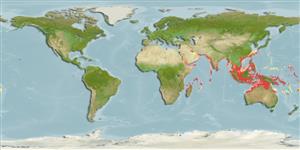Environment: milieu / climate zone / depth range / distribution range
Ecología
marino; salobre; rango de profundidad 15 - 100 m (Ref. 30573). Tropical; 30°N - 21°S, 36°E - 178°W
Indo-West Pacific: East Africa (Ref. 2871, 5213, 30573) to Southeast Asia, north to Japan, south to Queensland, Australia. Reported from Fiji (Ref. 12743).
Length at first maturity / Tamaño / Peso / Age
Maturity: Lm 15.0 range ? - 19.2 cm
Max length : 40.0 cm TL macho / no sexado; (Ref. 2872); common length : 30.0 cm TL macho / no sexado; (Ref. 2872)
Short description
Claves de identificación | Morfología | Morfometría
Espinas dorsales (total) : 8 - 9; Radios blandos dorsales (total) : 20 - 22; Espinas anales: 3; Radios blandos anales: 25 - 28. Silvery grey with blue iridescence dorsally, silvery white ventrally; upper part of gill cover with a dusky black spot; fins pale yellow. Mouth large and oblique.
Found in coastal waters down to a depth of about 100 m (Ref. 30573) and between 15-90 m in western Indonesia (Ref. 12260). Feeds on sand-dwelling animals (Ref. 5213). Marketed fresh and dried salted.
Life cycle and mating behavior
Madurez | Reproducción | Puesta | Huevos | Fecundidad | Larva
Paxton, J.R., D.F. Hoese, G.R. Allen and J.E. Hanley, 1989. Pisces. Petromyzontidae to Carangidae. Zoological Catalogue of Australia, Vol. 7. Australian Government Publishing Service, Canberra, 665 p. (Ref. 7300)
IUCN Red List Status (Ref. 130435: Version 2024-1)
Threat to humans
Harmless
Human uses
Pesquerías: comercial
Herramientas
Special reports
Download XML
Fuentes de Internet
Estimates based on models
Preferred temperature (Ref.
123201): 25.3 - 28.6, mean 27.6 °C (based on 746 cells).
Phylogenetic diversity index (Ref.
82804): PD
50 = 1.5000 [Uniqueness, from 0.5 = low to 2.0 = high].
Bayesian length-weight: a=0.01318 (0.00948 - 0.01833), b=2.94 (2.85 - 3.03), in cm total length, based on LWR estimates for this species (Ref.
93245).
Nivel trófico (Ref.
69278): 4.2 ±0.7 se; based on diet studies.
Resiliencia (Ref.
120179): Alto, población duplicada en un tiempo mínimo inferior a 15 meses (K=0.6).
Prior r = 0.75, 95% CL = 0.49 - 1.12, Based on 5 data-limited stock assessments.
Fishing Vulnerability (Ref.
59153): Low vulnerability (21 of 100).
Climate Vulnerability (Ref.
125649): High vulnerability (65 of 100).
Nutrients (Ref.
124155): Calcium = 157 [98, 292] mg/100g; Iron = 1.74 [1.04, 2.72] mg/100g; Protein = 19.2 [18.2, 20.2] %; Omega3 = 0.314 [0.186, 0.547] g/100g; Selenium = 50.3 [25.4, 103.9] μg/100g; VitaminA = 20.9 [7.9, 57.3] μg/100g; Zinc = 1.2 [0.9, 1.7] mg/100g (wet weight);
